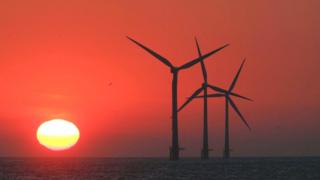INSUBCONTINENT EXCLUSIVE:
Image copyrightGetty ImagesWhen engineer Lukasz Cejrowski finally saw the world's largest wind turbine blades installed on a prototype
tower in 2016, he stood in front of it and took a selfie
Obviously."It was amazing," he says, recalling the moment with a laugh
"The feeling of happiness - 'Yes, it works, it's mounted.'"Those blades, made by Danish firm LM Wind Power, were a record-breaking 88.4m
(290ft) long - bigger than the wingspan of an Airbus A380, or nearly the length of two Olympic-sized swimming pools
The swept area of such a mammoth rotor blade would cover Rome's Colosseum.But things move quickly in the wind turbine industry
In just a few years, those blades could be surpassed by the company's next project - 107m-long blades.LM Wind Power is owned by global
engineering firm General Electric (GE), which announced in March that it hopes to develop a giant 12MW (megawatt) wind turbine by the year
Image copyrightLM Wind PowerImage caption
Lukasz Cejrowski says building the world's largest turbine blade felt
"amazing"
A single turbine this size, standing 260m tall, could produce enough electricity to power 16,000 households
The world's current largest wind turbine is a third less powerful than that, generating 8MW
Various companies, including Siemens, are working on turbines around the 10MW mark.When it comes to wind turbines, it seems, size matters
This is because bigger turbines capture more wind energy and do so at greater altitudes, where wind production is more consistent.But
designing and manufacturing blades of this size is a significant feat of engineering.Mr Cejrowski says that the firm could in theory use
metal, but the blades would be extremely expensive and heavy
Instead, they use a mix of carbon and glass fibre.Image copyrightLM Wind PowerImage caption
The scale of these mega wind
turbine blades is breathtaking
First, they make a glass-fibre and polyester shell for each blade - in two halves
Then the spar cap is added
That's a length of reinforcing material that runs down the inside of each of these halves
For this, Mr Cejrowski's team uses a glass-carbon composite fabric, infused with a special resin that hardens in place.These ultra-large
blades are extensively tested
Prototypes are bent, stretched, buffeted in wind tunnels and, during "fatigue tests", flexed back and forth quickly millions of times to
simulate a lifetime of use
They're also tested against lightning strike.The world's biggest wind turbines are generally installed offshore rather than on land
That way, they avoid being gigantic eyesores in our midst and are able to harness the powerful winds out at sea.Image copyrightSteffen
StampImage caption
Turbine blades are made from composite materials so they can flex and bend in high winds
On 17 March, more than a third of domestic electricity generation in Britain was achieved with wind power, the National Grid reported
This is a record.The potential of offshore wind has prompted some to draw up plans for future windfarms on an enormous scale, in waters many
US researchers recently showed that a huge amount of untapped energy could be harnessed by building a giant windfarm in the North
Atlantic.Separately, Dutch firm TenneT has developed a concept for a very large windfarm that could be built at Dogger Bank, an area of
shallow water in the North Sea.Image copyrightEPAImage caption
Offshore windfarms need huge electrical substations, like
this one heading to the Baltic Sea
It would include a man-made island where substations could be located and, with many
hundreds of turbines, supply power to countries including the UK, the Netherlands, Germany, Denmark and Sweden
In total, it could have a capacity of some 30GW (gigawatts), the company says.To put that in context, the average electricity demand for the
Henrik Stiesdal, a former chief engineer at Siemens' wind power division who now works at Danish Technical University, says there are
numerous advantages to building supersized offshore farms like this - even cosmetic benefits."If you're more than 40km (25 miles) out, the
curvature of the earth means the turbines will be below the horizon," he says.Mr Stiesdal says various organisations, including his own
institution and the University of Oxford, are working on ways to make offshore wind turbine foundations cheaper.Image copyrightLM Wind
PowerImage caption
Aerodynamics are key to efficient wind power generation
One idea is to develop
floating platforms that would be cheaper to manufacture in large quantities in factories
But if the cost of foundations does come down, it could then be cost-effective to install larger numbers of smaller turbines rather than
fewer big ones."The chasing of the big machines will continue only as long as the infrastructure costs are high," he explains.For this
reason, wind turbines are unlikely to exceed the 12MW models, he believes.One downside of building offshore windfarms with many smaller
turbines, though, is that there are many more individual bits of equipment needing to be serviced and maintained out at sea, where the
conditions can often be inhospitable, to say the least.For the more immediate future, expect to see offshore wind farms continue to
multiply, especially in Europe, says Joel Meggelaars at industry association Wind Europe."GE is definitely the biggest announcement that
we've seen so far," he says, referring to the planned 12MW turbine.Image copyrightGetty ImagesWind supplied more than 11% of Europe's
electricity in the first half of 2017, Wind Europe says
And Mr Meggelaars expects that percentage to grow, as more windfarms are installed."In 2019, we expect to see another record of offshore
wind being installed, around 4GW - again, most of that is in the UK and Germany."The main hurdle for potential projects such as Dogger Bank,
he adds, is governments having to co-operate with one another
It may be decades before a windfarm like that gets going
In the meantime, one initial benefit of increasingly large turbines is the falling cost of wind power, says Mr Meggelaars."It's absolutely
great news that these bigger turbines are on the horizon," he explains
"It will make renewables even cheaper."Follow Technology of Business editor Matthew Wall on Twitter and Facebook

